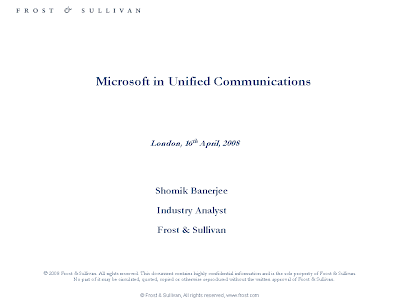Open Source in Europe. How much did you know?
Frost & Sullivan conducted extensive research on the open source market in Europe. I have reproduced the executive summary out here. For details on the complete report and how you can buy, please contact nils.frenkel@frost.com
Open Source telephony has come a long way since starting as a collaborative project amongst tech enthusiasts. Today it is used as the means of communication by an increasing number of businesses. Frost & Sullivan estimates that there are over 3300 businesses in Europe that have deployed commercial telephony products that use some kind of ‘open source code’.
The market is constantly being tapped by new players. Early entrants include ADDIX, Digium, ESCAUX, and Novacom who have generated quite a volume of business in the early years. New entrants in the market include players of different backgrounds such as
a) Community based vendors such as Fonality and PingTel
b) Channel partners of major PBX or IT/software vendors. There is a greater attraction amongst channel that deal with Linux.
c) Major PBX vendors such as 3Com, Aastra. It is known that Avaya and Nortel are building skills in this area as well.
d) Hardware vendors such as Dell, IBM and Sun
e) Carriers such as British Telecom
The level of interest can be gauged by the number of free downloads of the base software. In 2007 alone, approximately 800,000 copies of Asterisk and TrixBox software were downloaded in Europe. Interestingly, overall in Europe an estimated 200,000 are still alive and are known to send heartbeat signals back to the community.
Our market research indicates that deployments have been scattered in the sub 500 user segment. The largest deployment that we studied was of 850 users by Novacom, which we have developed into a case study in the report. The complexity that some of these vendors deal with span from simple call routing to support sophisticated call centre application. ADDIX, for instance, has been successful in deploying a number of call centre solutions in Germany.
The total installed base of “open source” based systems in Europe is less than 1 percent of the market. There are numerous challenges that open source telephony vendors and channel partners need to overcome in order to be considered as a viable alternative in the market. A number of changes in the market dynamics favour the growth in momentum of open source telephony. The break-down of vertically-integrated industry structure is inline with the value proposition of “open source”. The ability to develop call processing software using open-source code running on off-the-shelf hardware and OS is expected to alter the telephony architecture in a number of organisations. Frost & Sullivan believes that with the right marketing strategy, ‘open source’ telephony will grow considerably.











